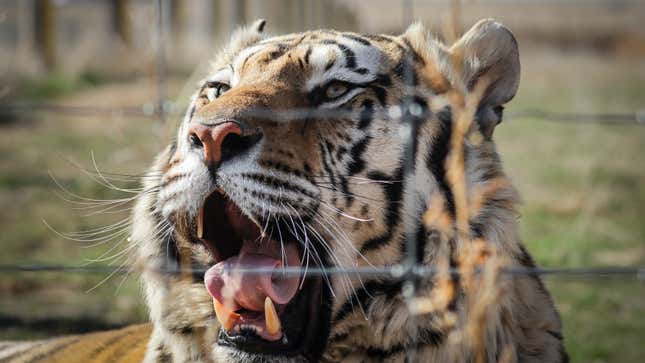
Currently, across the U.S., an estimated 20,000 big cats are privately kept as pets or as roadside zoo attractions, with many living in squalor cages and malnourished misery. They are beaten to succumb to performance. And some are even slaughtered or sold for parts once outlive their utility as cub petting acts. But, big cats in the U.S. are now on track to get the long-awaited protections they deserve.
Yesterday evening, big cats in the U.S. gained a monumental stride on the road to securing more comprehensive protection across the country. After well over a decade of iterations, the Big Cat Public Safety Act (H.R. 1380) passed through the House of Representatives by a vote of 272-114.
Co-sponsored by Rep. Mike Quigley and Rep. Brian Fitzpatrick, the bill aims to limit and ban private possession of tigers, lions, leopards, jaguars, cougars, cheetahs, and any hybrid of these species. It will also strictly prohibit any public interaction with big cats, including cub petting and selfie photo ops.
Currently, the national number of big cats in private possession is unknown and undocumented at the federal level. The eventual passing of the legislation will set the course for federal officers to handle the scope of private possession and allow law enforcement to manage related dangers of these apex predators in private hands. Presently, animal welfare organizations moderately estimated that there are 10,000 to 20,000 privately-kept big cats in the U.S., and that 7,000 of those are tigers alone.
“By requiring facilities to obtain a federal permit for big cat ownership, this bill helps provide a full picture of where captive tigers are in this country, in addition to who owns them, when they’re sold or traded and what happens to their valuable parts when they die,” said Leigh Henry, Director of Wildlife Policy at World Wildlife Fund (WWF). “Currently, the lack of uniformity and information that exists increases the likelihood that captive tigers can easily slip off the radar and filter into illegal wildlife trade.”
As of today, obtaining a big cat in many states is sometimes even easier than adopting a shelter cat. The Big Cat Public Safety Act (BCPSA) will enact strict regulations in being able to attain a big cat in the first place.
The cruelty big cats endure in private possession and at roadside zoos is startling. Co-sponsor of the bill, Rep. Mike Quigley states, “animals like tigers, lions, leopards, and pumas should not be exposed to miserable conditions so many of them in our country currently face.”
The currently unchecked cub petting practice is leading to a mass breeding of tigers, animal welfare violations, and unregulated trade and slaughter of outgrown cubs. Banning cub petting is one of the Big Cat Public Safety Act’s hallmarks, and this legislation will ultimately lead to a dramatic downturn in breeding and big cat exploitation.
The dangers of humans being in close proximity or cohabitating with a 600-pound tiger is incontestable.
“Big cats are wild animals that simply do not belong in private homes, backyards, or shoddy roadside zoos,” stated Rep. Mike Quigley. “Too often, law enforcement and first responders are the ones who end up in danger from these animals and, in a time when our first responders are already facing increased risk from the pandemic, we owe it to them to limit the additional dangers they face on the job.”
Over 30 years, the Humane Society of the United States documented over 400 dangerous incidents that involved captive big cats in 46 states and the District of Columbia, with more not being reported and occurring by the day. Public safety officers are often the first on the scene and are subject to very real endangerment. For that reason, the Fraternal Order of Police, the National Sheriff’s Association, and numerous other state and local law enforcement agencies are proponents of the Big Cat Public Safety Act.
“By passing the Big Cat Public Safety Act we are one step closer to ensuring these animals are treated humanely and to keeping the public safe from dangerous big cats,” stated Rep. Mike Quigley after yesterday’s success. “It is my hope that the Senate will quickly bring this bill to the floor so we can get it signed into law before the year ends.”
The passing of this bill through the House is the first big step in protecting big cats from cruelty and unchecked breeding in the U.S.
“By passing the Big Cat Public Safety Act, Congress can send a message to the world that the U.S. will continue to stand strong against wildlife crime,” said Leigh Henry of WWF. “Our hope is that stricter regulation of captive tigers in the U.S. will be just the beginning of a global trend – and a more secure future for tigers in the wild.”
In the face of the covid-19 pandemic and the now-recognized human role in the spread of zoonotic disease, the passing of the bill is the first of many steps needed to curb our global exploitation of wildlife and to protect the endangered tigers, lions, and other species in their wild landscapes.
Rina Herzl is a freelance journalist covering pressing environmental and wildlife conservation issues. She has authored articles for Earther, Earth Island Journal, Mongabay, and EcoWatch.